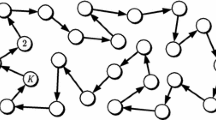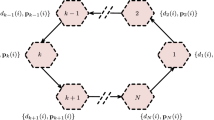Abstract
In distributed networks, the conventional incremental mode of cooperation between the nodes may suffer instability due to two major reasons: (1) large local errors due to accidental problems, and (2) instability due to link failure or noisy link. This causes error propagation through the entire network resulting in divergence. In this research, we propose a novel incremental least mean square algorithm with improved stability by employing convex combination of two filters. Adaptation of one filter is based on the estimate of the adjacent node (incremental type), while that of the other is based on the estimate of the current local node at previous time instant. These two filters are then fused together by using a suitable mixing parameter. An adaptive mixing parameter is further proposed for this convex combination, ensuing dynamic assignment of the weights for the two combining filters. Steady state excess mean square error is derived for the proposed convex combination, and simulations are presented to validate the proposed claims.










Similar content being viewed by others
Notes
Since the ILMS algorithm is developed in [20] for strongly connected network, therefore in this analysis \(\alpha \) is taken to be 1.
References
U.M. Al-Saggaf, M. Moinuddin, A. Zerguine, M. Arif, The q-least mean squares algorithm. Signal Process 111(C), 50–60 (2015)
A.U. Al-Saggaf, M. Arif, U.M. Al-Saggaf, M. Moinuddin, The q-normalized least mean square algorithm. in 6th International Conference on Intelligent and Advanced Systems, pp. 1-6 (2016)
M. Arif, I. Naseem, M. Moinuddin, U.M. Al-Saggaf, Design of optimum error nonlinearity for channel estimation in the presence of class-A impulsive noise. in 2016 6th International Conference on Intelligent and Advanced Systems, pp. 1–6 (2016)
M. Arif, I. Naseem, M. Ashraf, M. Moinuddin, Design of incremental optimum error nonlinearity for distributed networks. in International Conference on Innovations in Electrical Engineering and Computational Technologies, pp. 1–5 (2017)
F.S. Cattivelli, A.H. Sayed, Diffusion LMS strategies for distributed estimation. IEEE Trans. Signal Process. 55(3), 1035–1048 (2010)
F.S. Cattivelli, A.H. Sayed, Self-organization in bird flight formations using diffusion adaptation. in Presented at the Proceedings of 3rd International Workshop Computational Advances Multi-Sensor Adaptive Processing (CAMSAP), Aruba, Dutch Antilles (2009)
J. Chen, A.H. Sayed, Distributed Pareto optimization via diffusion strategies. IEEE J. Sel. Topics Signal Process. 7(2), 205–220 (2013)
J. Chen, A.H. Sayed, Diffusion adaptation strategies for distributed optimization and learning over networks. IEEE Trans. Signal Process. 60(8), 4289–4305 (2012)
D. Estrin, G. Pottie, M. Srivastava, Instrumenting the world with wireless sensors networks. in Proceedings of IEEE International Conference Acoustics, Speech, Signal Processing (ICASSP), Salt Lake City, UT, pp. 2033–2036 (2001)
J.A. Garcia, A.R.F. Vidal, A.H. Sayed, Mean-square performance of a convex combination of two adaptive filters. IEEE Trans. Signal Process. 54(3), 1078–1090 (2006)
M.R. Gholami, M. Jansson, E.G. Strom, A.H. Sayed, Diffusion estimation over cooperative multi-agent networks with missing data. IEEE Trans. Signal Inf. Process. Over Netw. 2(3), 276–289 (2016)
I.S. Gradshteyn, I.M. Ryzhik, Table of Integrals, Series, and Products (Elsevier/Academic Press, Amsterdam, 2007)
A. Khalili, M.A. Tinati, A. Rastegarnia, Performance analysis of distributed incremental LMS algorithm with noisy links. Int. J. Distrib. Sens. Netw. 7(1), 756–767 (2011)
A. Khalili, M.A. Tinati, A. Rastegarnia, Steady-state analysis of incremental LMS adaptive networks with noisy links. IEEE Trans. Signal Process. 59(5), 2416–2421 (2011)
C.G. Lopes, A. H. Sayed, Diffusion adaptive networks with changing topologies. in Proceedings of IEEE ICASSP, Las Vegas, NV, pp. 3285–3288 (2008)
C.G. Lopes, A.H. Sayed, Incremental adaptive strategies over distributed networks. IEEE Trans. Signal Process. 55(8), 4064–4077 (2007)
C.G. Lopes, A. H. Sayed, Randomized incremental protocols over adaptive networks. in IEEE International Conference on Acoustics, Speech and Signal Processing, pp. 3514–3517 (2010)
C.G. Lopes, A.H. Sayed, Diffusion least-mean squares over adaptive networks: formulation and performance analysis. IEEE Trans. Signal Process. 54(7), 3122–3136 (2008)
C.G. Lopes, A. H. Sayed, Distributed adaptive incremental strategies: formulation and performance analysis, in Proceedings of IEEE International Conference Acoustics, Speech, Signal Processing (ICASSP), Toulouse, France, vol. 3, pp. 584–587 (2006)
C.G. Lopes, A.H. Sayed, Incremental adaptive strategies over distributed networks. IEEE Trans. Signal Process. 55(8), 4064–4077 (2007)
A. Papoulis, S.U. Pillai, Probability, Random Variables, and Stochastic Processes (McGraw Hill, New York, 2002)
A.H. Sayed, Fundamentals of Adaptive Filtering (Wiley-Interscience, New York, 2003)
A.H. Sayed, T.Y. Al-Naffouri, Optimum Error Nonlinearities for Long Adaptive Filters. in Proceedings of ICASSP, (2002)
L. Xiao, S. Boyd, S. Lall, A scheme for robust distributed sensor fusion based on average consensus. in Proceedings of 4th International Symposium Information Processing in Sensor Networks, Los Angeles, CA, pp. 63–70 (2005)
C. Yin, S. Wu, S. Zhou, J. Cao, Y. Cheng, Design and stability analysis of multivariate extremum seeking with Newton method. J. Frankl. Inst. 355(4), 1559–1578 (2018)
C. Yin, S. Dadras, X. Huang, J. Mei, Y. Cheng, Energy-saving control strategy for lighting system based on multivariate extremum seeking with Newton algorithm. IEEE Trans. Signal Process. 142, 504–522 (2017)
Acknowledgements
This project was funded by the Center of Excellence in Intelligent Engineering Systems (CEIES), King Abdulaziz University, under grant No. (CEIES-16-12-03). The authors, therefore, acknowledge the technical and financial support of CEIES. The authors also acknowledge the support of Karachi Institute of Economics and Technology (PAF-KIET) Pakistan in facilitating this research.
Author information
Authors and Affiliations
Corresponding author
Additional information
Publisher's Note
Springer Nature remains neutral with regard to jurisdictional claims in published maps and institutional affiliations.
A Derivation of First-Order and Second-Order Moments
A Derivation of First-Order and Second-Order Moments
For the sake of simplicity, let \(\varDelta \psi _{k}(n)=x\). Hence, x is central Chi-squared centered random variable with M degrees of freedom and its probability density function (pdf) is [21]:
Consequently, the first-order moment of \(h_{k}(n)\) can be evaluated as:
after some straight forward calculations, (55) can be set up as
where \(x'=ax\) and \(p=\frac{1}{2\sigma ^{2}a}-1\). The closed for solution of (56) can be evaluated as [12]:
In the same manner, the second-order moment of \(h_{k}(n)\) can be set up as:
after some straight forward calculations (58) are found to be:
The closed-form solution of (59) can be written as [12]:
Rights and permissions
About this article
Cite this article
Arif, M., Naseem, I., Moinuddin, M. et al. Modified Incremental LMS with Improved Stability via Convex Combination of Two Adaptive Filters. Circuits Syst Signal Process 38, 4245–4265 (2019). https://doi.org/10.1007/s00034-019-01061-w
Received:
Revised:
Accepted:
Published:
Issue Date:
DOI: https://doi.org/10.1007/s00034-019-01061-w




